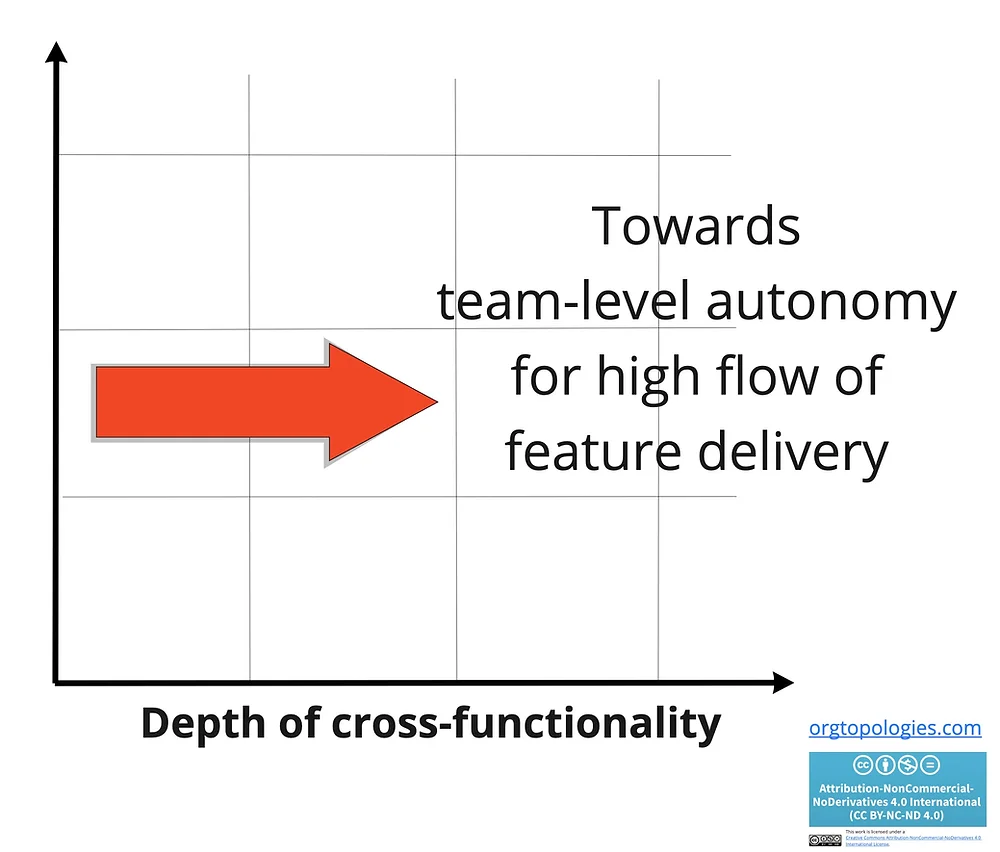What is Org Topologies™?
Agile transformation is a highly contextual journey. We believe one essential meta objective of every business is to stay resilient for as long as possible in the face of competition and market landscape changes.
This means applying an org design that maximizes adaptivity to keep discovering constantly changing market demands, but at the same time, keep delivering the value that is known to be needed.
Structurally, this requires investing in improvements along two axes:
-
Grow team-level autonomy – by deepening cross-functionality to deliver value fast.
-
Grow customer-centric alignment – by broadening understanding of the problem space.
Org Topologies™ enables change agents to choose an org design that allows them to grow their organization along these two axes and embrace holistic product development with high adaptivity, innovation, and resilience.
Growing Team-Level Autonomy
 For many organizations we know, "agile transformation" means creating "agile teams". This is indeed a step in the right direction. However, it is impossible to get to a higher state of adaptivity by relying on individualistic work. Jelled groups of people organized in teams are better at adapting to changing environments than individuals. Teams absorb the complexity of uncertainty, acquire new skills, and discover and deliver at the same time.
For many organizations we know, "agile transformation" means creating "agile teams". This is indeed a step in the right direction. However, it is impossible to get to a higher state of adaptivity by relying on individualistic work. Jelled groups of people organized in teams are better at adapting to changing environments than individuals. Teams absorb the complexity of uncertainty, acquire new skills, and discover and deliver at the same time.
Organizational improvements along this dimension increase the capabilities of teams to work across the entire technology stack, delivering results faster and in a constant flow. This dimension is closely related to what Scrum calls the "Definition of Done" and the DevOps call techniques of "Continuous Delivery".
Mastering this dimension allows teams to work on customer problems end-to-end. "End-to-end" means that teams don't have blocking dependencies between each other - i.e. no queues, no waiting, no hand-offs, no victimization or unclarity of responsibility. Lean production requires multi-trained individuals in cross-functional teams to improve delivery and learning. We see organizations tend to focus most on this dimension: Creating better teams.
Yet, from our experience of years of consulting, focusing only on improving the performance of individual teams is not enough. When each team focuses on a specific aspect of a product (such as a certain feature or a product capability, e.g. the product catalogue search) the joint result of all the teams will unlikely provide a seamless and joyful customer experience (e.g. finding and buying a product at minimal clicks). The product might look like a Frankenstein to its customers, lacking holistic design.
Growing Product-Centric Alignment

As we mentioned above, improving performance of individual teams is not enough to provide good customer experience. And also, when teams are driven by narrow focus and local interests, this creates a fragmented and conflicting view of reality, jeopardizing the organization's general ability to foresee upcoming changes and adapt at the customer level.
So organizations also need to focus on a second dimension we call "Value Consolidation". It means how broadly and holistically do teams, departments and the entire organization understand the value they deliver to their customers.
Value consolidation implies enabling teams to work together with broader focus and wider responsibilities. Not only cross-functionally, but also product-wide thinking of integrated user journeys and holistic customer experiences.
In practice, such organizations have fewer backlogs, fewer roles, and less bureaucracy. There are fewer steering wheels to be turned when the organization needs to adjust its course. This is a better fit for adaptivity.
High Adaptivity as a Target

Organizational transformation is not a project with a fixed end date. It is an ongoing learning effort to get closer to the ideal state, making incremental changes over time.
And what is this ideal state worth pursuing?
We believe it is an organizational ability (of all the employees, teams and departments) to re-focus and keep doing what's most important and most valuable at any given moment. This is a state of high organizational adaptivity. And your organization can get better at it, continuously improving its fit for adaptivity .
We discovered that both dimensions need to be developed and matched on the journey of making your organization more adaptive.
What is Org Design Mapping?
The Org Topologies™ map consists of seven organizational archetypes. They are positioned on the map in relation to their structure along both axes and in proximity to the perfection-vision of high adaptability.
Org Topologies™ is an org design mapping technique that helps you:
-
Assess the org design of your product development organization.
-
Determine your roadmap towards organizational perfection – higher adaptivity, innovation, and resilience.
The illustrations below are examples of org design mapping that can help you make better-informed decisions on the direction of your agile transformation efforts. For more information and downloads, check OrgTopologies.com.

